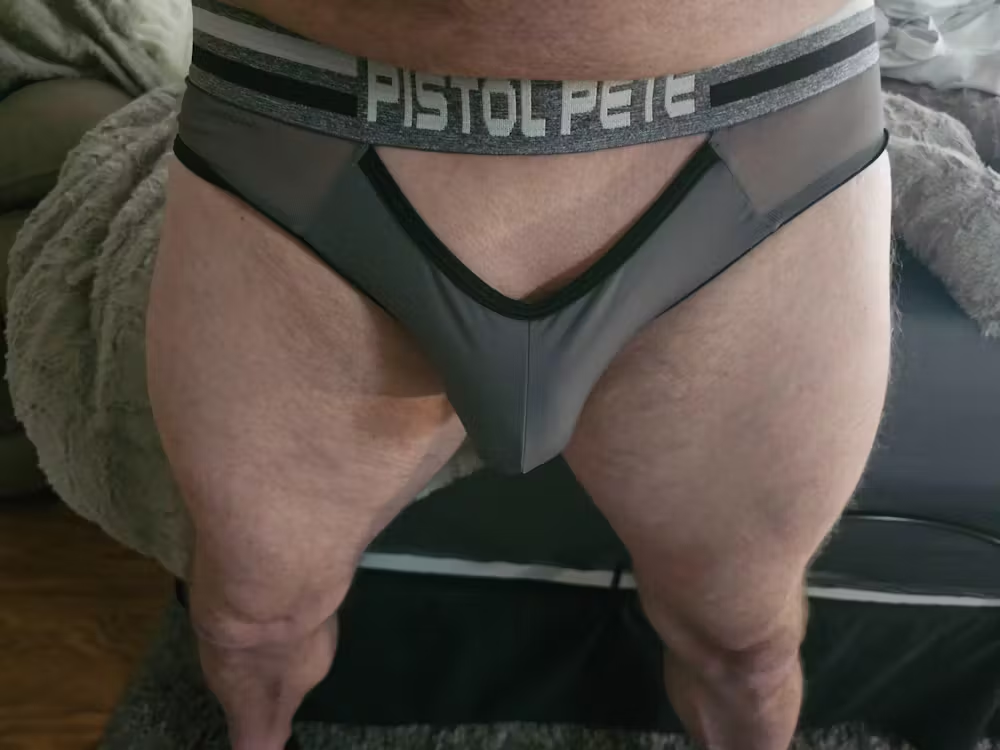Why Mesh Apparel Deserves Your Attention
Let's cut to the chase – mesh apparel isn't just about looking good (though it absolutely delivers on that front). It's about embracing breathability, comfort, and that unmistakable confidence that comes with wearing gear designed for the modern man who knows what he wants.
Mesh fabrics have revolutionized men's intimate apparel and activewear. The intricate weave patterns create microscopic ventilation channels that promote airflow while maintaining structural integrity. But here's the thing nobody talks about: mesh is surprisingly delicate despite its robust appearance.
Your investment in quality mesh pieces deserves protection. Whether we're talking about that show-stopping jockstrap or your favorite mesh tank, proper care extends longevity and preserves the aesthetic appeal that drew you to these pieces initially.
Understanding Mesh Fabric Construction
Before diving into care specifics, let's demystify what you're actually working with. Mesh isn't a one-size-fits-all category – it encompasses various weave structures and material compositions that directly impact how you should approach maintenance.
Synthetic Mesh Varieties
Most contemporary mesh apparel utilizes synthetic fibers like polyester, nylon, or specialized blends. These materials offer superior moisture-wicking properties and enhanced durability compared to natural alternatives. However, synthetic meshes are particularly susceptible to heat damage and chemical degradation from harsh detergents.
Polyester mesh maintains color vibrancy longer but can develop static cling issues. Nylon variants offer exceptional stretch recovery but require gentler handling to prevent snagging. Understanding your specific mesh composition helps tailor your care approach accordingly.
Natural and Blended Options
Some premium mesh garments incorporate cotton or bamboo fibers for enhanced comfort against sensitive skin. These natural elements introduce different care considerations – they're more prone to shrinkage but generally more forgiving with temperature fluctuations.
Blended mesh fabrics attempt to capture the best of both worlds, combining synthetic durability with natural breathability. These hybrids often require the most nuanced care approach, as you're essentially caring for multiple fiber types simultaneously.
Essential Pre-Wash Preparation
Preparation is everything when it comes to mesh apparel care tips that actually work. Rushing into the washing process without proper preparation is where most people sabotage their favorite pieces.
Inspection and Sorting Protocols
Start with a thorough inspection of each garment. Look for loose threads, areas where the mesh appears stretched or distorted, and any visible stains or discoloration. This preliminary assessment helps you identify pieces that need special attention or hand treatment.
Sorting goes beyond simple color separation. Group items by mesh density, fabric weight, and care requirements. Your lightweight mesh underwear shouldn't share a wash cycle with heavy athletic mesh shorts – the agitation differences can cause damage to delicate pieces.
For our fashion-forward community at DealByEthan.gay, we understand that your mesh collection likely includes pieces with varying levels of boldness and delicacy. That rainbow mesh brief deserves the same meticulous care as your classic black jockstrap.
Stain Treatment Strategies
Mesh's open weave structure means stains can penetrate deeper than with solid fabrics. Address spots immediately when possible, but avoid aggressive rubbing that can distort the mesh pattern.
Create a gentle pre-treatment solution using cold water and a small amount of enzyme-based detergent. Dab rather than rub, allowing the solution to penetrate naturally. For protein-based stains (sweat, body oils), cold water prevents setting, while gentle enzymes break down the compounds without harsh scrubbing.
"The key to maintaining mesh apparel longevity lies in treating each piece as the specialized garment it is, not just another item in your laundry pile."
Optimal Washing Techniques
Now we get to the heart of mesh apparel care tips – the actual washing process. This is where most people either preserve their investment or inadvertently destroy it.
Temperature and Cycle Selection
Cold water is your mesh apparel's best friend. Temperatures above 80°F can cause synthetic fibers to lose elasticity and may lead to permanent deformation of the mesh structure. The delicate or hand-wash cycle minimizes mechanical stress while still providing adequate cleaning action.
If your washing machine has specific synthetic fabric settings, use them. These programs typically feature reduced agitation and shorter spin cycles that protect mesh integrity while ensuring thorough cleaning.
Consider the CandyMan 99842 Jockstrap as a perfect example of mesh craftsmanship that demands proper care. This piece combines aesthetic appeal with functional design, featuring strategically placed mesh panels that enhance both comfort and visual impact. The intricate mesh detailing requires gentle handling to maintain its structural integrity and vibrant appearance. When cared for properly using these techniques, pieces like this maintain their shape and color intensity wash after wash.
Detergent Selection and Usage
Not all detergents are created equal when it comes to mesh fabrics. Harsh chemicals can break down synthetic fibers and cause colors to fade prematurely. Opt for detergents specifically formulated for synthetic fabrics or those labeled as suitable for athletic wear.
Liquid detergents generally outperform powder alternatives for mesh care. Powder residues can accumulate in mesh openings, creating buildup that affects breathability and appearance. Use approximately half the recommended amount – mesh garments typically don't require heavy-duty cleaning unless heavily soiled.
Fabric softeners are generally contraindicated for mesh apparel. They can coat fibers, reducing moisture-wicking properties and creating a film that attracts dirt and bacteria over time.
Professional Mesh Collection Care
When you've invested in a comprehensive mesh collection, having a systematic approach becomes crucial. Our curated mesh collection at DealByEthan.gay represents some of the finest mesh craftsmanship available, spanning from everyday comfort pieces to statement-making designs that celebrate body positivity and personal expression. Each piece in this collection has been selected for its quality construction and attention to detail, making proper care essential for maintaining their intended aesthetic and functional properties.
A well-maintained mesh collection requires organization and consistency. Develop a routine that addresses the varying needs within your collection while maintaining efficiency. This might mean dedicating specific wash days to mesh items or creating separate care protocols for different mesh densities and constructions.
Drying Methods That Preserve Integrity
The drying phase is where many well-intentioned care routines go sideways. Mesh fabrics require specific drying approaches to maintain their shape, elasticity, and overall appearance.
Air Drying Best Practices
Air drying is the gold standard for mesh apparel longevity. However, it's not as simple as hanging everything on a line and hoping for the best. Proper air drying involves strategic positioning and environmental consideration.
Lay flat drying works best for most mesh garments. This prevents stretching and distortion that can occur with hanging methods. Use a clean, absorbent towel as your base, and reshape the garment to its intended dimensions before leaving it to dry.
Avoid direct sunlight, which can cause color fading and may weaken synthetic fibers over time. Instead, choose a well-ventilated area with indirect light. Good airflow accelerates drying while preventing the musty odors that can develop in stagnant conditions.
Heat Drying Considerations
While air drying is preferred, sometimes machine drying becomes necessary. When using a dryer, select the lowest heat setting available – many modern dryers offer "air fluff" or "no heat" options that work perfectly for mesh items.
Remove mesh garments while they're still slightly damp. This prevents over-drying, which can make synthetic fibers brittle and prone to cracking. The residual moisture will evaporate naturally without compromising the fabric structure.
Storage Solutions for Longevity
Proper storage extends the life of your mesh apparel between wears. The way you store these pieces directly impacts their shape retention and overall condition.
Folding vs. Hanging Strategies
Most mesh underwear and intimate apparel should be folded rather than hung. Hanging can create stress points where the garment contacts hangers, leading to permanent stretching or distortion.
When folding, avoid sharp creases that might create permanent lines in the mesh pattern. Instead, use gentle curves and natural fold lines that follow the garment's construction.
| Storage Method | Best For | Avoid With |
|---|---|---|
| Flat folding | Mesh underwear, briefs, jockstraps | Heavily structured pieces |
| Padded hangers | Mesh tanks, lightweight shirts | Delicate mesh details |
| Drawer organization | Frequently worn pieces | Long-term storage |
Environmental Factors
Storage environment matters more than most people realize. Humidity extremes can affect synthetic mesh fibers, while temperature fluctuations may cause expansion and contraction that stresses the fabric structure.
Maintain consistent, moderate conditions in storage areas. Cedar blocks or lavender sachets can provide natural freshness without the chemical concerns associated with synthetic air fresheners that might interact with mesh materials.
Troubleshooting Common Mesh Issues
Even with perfect care routines, mesh apparel can develop issues over time. Understanding how to address common problems helps extend garment life and maintain appearance.
Addressing Shape Distortion
Mesh garments that lose their shape can often be restored with gentle intervention. For minor stretching, try dampening the affected area with cool water and carefully reshaping while damp. Allow to air dry completely while maintaining the corrected shape.
Severe distortion typically indicates fiber damage that can't be fully reversed. However, you can often minimize the appearance by adjusting how you store and wear the garment.
Managing Snags and Pulls
Snags in mesh fabric require immediate attention to prevent spreading. Never pull on loose threads – this can unravel larger sections of the mesh pattern.
Instead, use a small crochet hook or needle to gently work the snagged thread back through to the reverse side of the fabric. This technique often makes minor snags virtually invisible from the exterior.
Frequency and Timing Guidelines
How often should you wash mesh apparel? The answer depends on several factors including wear duration, activity level, and personal comfort preferences.
- Underwear and intimate mesh pieces: After each wear
- Activewear mesh garments: After each workout session
- Casual mesh tops: Every 2-3 wears, depending on conditions
- Decorative mesh pieces: As needed, based on visible soiling
Remember that mesh's breathable nature means it doesn't trap odors as readily as solid fabrics, but the intimate nature of most mesh apparel makes frequent washing a hygienic necessity.
Advanced Care Techniques
For those ready to take their mesh apparel care to the next level, several advanced techniques can further extend garment life and maintain peak appearance.
Rotation Strategies
If you've invested in multiple similar pieces, implement a rotation system that prevents any single garment from excessive wear. This approach is particularly valuable for favorite pieces that might otherwise be overworn.
Document wash cycles for premium pieces. Tracking washing frequency helps identify when garments might need replacement and ensures you're getting maximum value from your investment.
Seasonal Considerations
Mesh apparel care requirements can shift with seasonal changes. Summer's increased wear frequency and higher sweat production demands more frequent washing, while winter storage periods require different preparation approaches.
Before long-term storage, ensure all mesh pieces are completely clean and dry. Even minor residues can attract insects or develop odors during extended storage periods.
When to Seek Professional Care
Some mesh garments benefit from professional cleaning, particularly those with complex construction or mixed materials. Specialty lingerie or high-end mesh pieces with delicate detailing might warrant professional attention.
Look for dry cleaners experienced with synthetic fabrics and athletic wear. Standard dry cleaning chemicals can be too harsh for some mesh constructions, so communication about fabric content is crucial.
Professional cleaning becomes essential when dealing with stubborn stains that home treatment can't address, or when garments show signs of deterioration that might benefit from professional assessment.
Your mesh apparel represents more than just clothing – it's an expression of personal style and confidence. These mesh apparel care tips ensure your investment continues delivering the comfort, appearance, and satisfaction you deserve. Take the time to implement proper care routines, and your favorite pieces will reward you with extended life and consistent performance.



















0 comments